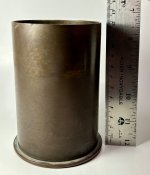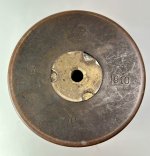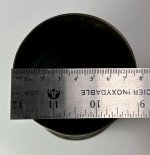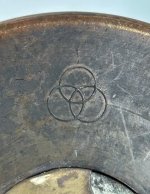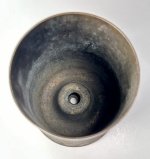You are using an out of date browser. It may not display this or other websites correctly.
You should upgrade or use an alternative browser.
You should upgrade or use an alternative browser.
Identification help needed with shell case
- Thread starter Hallibag
- Start date
Kaiser Wilhelm II
Well-known member
I do not know much about these, so take it for what you wish, but in my personal opinion, it is a standard 77mm shell, that for whatever reason has been cut down. Its hard to tell in these photos, but it looks like it may be cut. However I'm sure you have already considered this. Another possibility is maybe a field alteration, like trench art. The only other thing I could think of would be an experimental shell type by Krupp. I hope you find more out than what I can say.
Thank you for your reply! I could be wrong, of course, but I don’t believe the case has been cut down, and have just discovered in another discussion group that there was a 7.7cm by 118mm case with a primer of the same size as this one used, apparently, in shells for Blockhauskanonen installed in the fortresses around Metz.I do not know much about these, so take it for what you wish, but in my personal opinion, it is a standard 77mm shell, that for whatever reason has been cut down. Its hard to tell in these photos, but it looks like it may be cut. However I'm sure you have already considered this. Another possibility is maybe a field alteration, like trench art. The only other thing I could think of would be an experimental shell type by Krupp. I hope you find more out than what I can say.
I’ve found an extremely similar shell case with the same dimensions as my case which, apparently, was made for blockhauskanonen in the fortresses at Metz. It seems the short shell case held a reduced charge, as the guns needed to have a short recoil due to the confined spaces in which they were installed. Has anyone heard of this? I’d love to know more about the blockhauskanone, and see a photo of what the gun looked like.
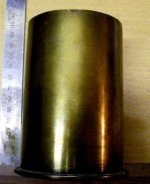
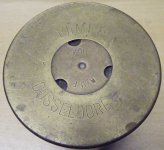


Peter B
Well-known member
This is very interesting to me as a retired Artillery officer. In our 105s Howitzers we simply reduced the number of charge bags in the casing for shorter ranges and yes it would affect recoil. There were seven charge bags in total. We used the Italian L5 Pack Howitzer when I was in the Parachute Battery and we were never allowed to fire charge seven (largest charge with seven charge bags) as it would damage the recoil. Maybe they did not use charge bags back then.I’ve found an extremely similar shell case with the same dimensions as my case which, apparently, was made for blockhauskanonen in the fortresses at Metz. It seems the short shell case held a reduced charge, as the guns needed to have a short recoil due to the confined spaces in which they were installed. Has anyone heard of this? I’d love to know more about the blockhauskanone, and see a photo of what the gun looked like.
View attachment 41919
View attachment 41920
One of the duties of the safety officer when we left a gun position was to collect all the unused charge bags and lay them out in a safe area in a nice straight line and then burn them.
CLOVIS 57
Well-known member
Hello,
Many of the forts around Metz were protected by eclipse turrets, with 2 howitzers and a very short barrel for curved or taut shot . Because of the short length of the barrel, the casing had to be short too, to allow the shell to be guided as well as possible.
https://www.google.com/search?q=tou...Qg4MDY3ajBqN6gCALACAA&sourceid=chrome&ie=UTF- 8#ip=1
During the annexation of Alsace-Lorraine, the calibre was German (77mm), then for the Maginot Line, the guns were French (75mm).
 www.darkplaces.org
www.darkplaces.org
The advantage of these turrets was that they had a small grip and, in the event of a bombardment, could slip away thanks to a counterweight balance system. A single man could manoeuvre the several-tonne unit with a simple crank.
Many of the forts around Metz were protected by eclipse turrets, with 2 howitzers and a very short barrel for curved or taut shot . Because of the short length of the barrel, the casing had to be short too, to allow the shell to be guided as well as possible.
https://www.google.com/search?q=tou...Qg4MDY3ajBqN6gCALACAA&sourceid=chrome&ie=UTF- 8#ip=1
During the annexation of Alsace-Lorraine, the calibre was German (77mm), then for the Maginot Line, the guns were French (75mm).
Les tourelles à éclipse
The advantage of these turrets was that they had a small grip and, in the event of a bombardment, could slip away thanks to a counterweight balance system. A single man could manoeuvre the several-tonne unit with a simple crank.
Thank you! Very interesting.Hello,
Many of the forts around Metz were protected by eclipse turrets, with 2 howitzers and a very short barrel for curved or taut shot . Because of the short length of the barrel, the casing had to be short too, to allow the shell to be guided as well as possible.
https://www.google.com/search?q=tou...Qg4MDY3ajBqN6gCALACAA&sourceid=chrome&ie=UTF- 8#ip=1
During the annexation of Alsace-Lorraine, the calibre was German (77mm), then for the Maginot Line, the guns were French (75mm).
Les tourelles à éclipse
www.darkplaces.org
The advantage of these turrets was that they had a small grip and, in the event of a bombardment, could slip away thanks to a counterweight balance system. A single man could manoeuvre the several-tonne unit with a simple crank.

